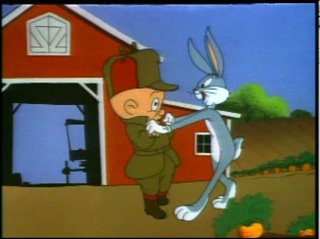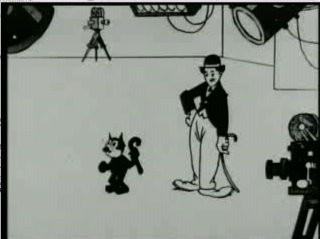
Robot Rabbit
1953-12-12
Friz Freling
See
http://hellonfriscobay.blogspot.com/
for the Friz Freling Blogathon, which this post has been made because of.
Love:

Title card painting. The weird angles on the robot Bugs are pleasing, as are the colors.
"Downa Indiana way..." Technically known as "In a Little Red Barn (On a Farm Down in Indiana)", the song is cool as a setup for bringing Elmer and Bugs together. It's not as well done as the opera singer using the song to bring Bugs and his antagonist together, but it's still cool.

Kick the bucket. Having Bugs and Elmer sing together again is kinda repeptitive, but the whole kick the bucket thing is a prime combination of a physical gag with verbal humor, as well as comic misdirection of the antagonist, followed by ...

Elmer's disengegement, the classic end to the playalong joke. The buggy in the barn is great in silhouette, too. Unfortunately, it goes on too long with Elmer stunned, and just ends up kinda falling flat as it drags on. Fortunately, the disengagement is followed by Bugs jumping in a hole leading to...

Flopping carrots. It's very satisfying for Bugs going to ground so hard that the carrots in his hole bounce like popcorn on a tympani.

Electronic Robot box. Mmm, paintings. The text is straight forward, and the font conveys plenty about the product without a messy little logo. Technical manual writers would do well to study the branding of the Electronic Robot line of products.

Flopping robot. Before there were flopping carrots, afterwards, its ass will fall off. Here is the middle state; starting up, the thing is shaking apart at the seams. Not the best idea in designing your robot, I think you'll agree, but it looks cool on screen.

Future gun. Great painting, great gun design. If only the entire cartoon had the color sense of the paintings...

Donkey's "whad I do? Whad I do?". The line is great. His post blasting head is as ugly as the testicle hanging out of the shorts of the old guy down the street, tho.

Evil painted robot. A still painting plus cels conveys a lot of anger and frustration.

Rusting painted robot. The sound of Elmer's oil can is cool with this, combined with the painting itself and the rusting effect is just a very tasty visual.


Robo drag. When Bugs is ugly (like in this cartoon), there's nothing like putting a bucket on his head to make a robot want to fuck him...

Robot falling ass, now with sputtering! I wonder if the sides flying off is what caused the robo bottom to drop out, or if the bottom was falling and in a safety measure the sides were blown off like a cockpit in a fighter plane...
Hate:

Ugly bugs. He's off kilter in the box, but the problem with this and most of the Freling cartoons is that Bugs looks boring/ugly. Chuck Jones got out of control later on, but at least his Bugses (yeah, I spelled it) were always interesting (by the '50s, at least).
Lame Elmer and Bugs interaction. Elmer is frustrating, Bugs is irritating. Gee, just what I want to see. And when they get together? Oh, the crappiness... It's like they're actors sleepwalking through cliched roles they've done a thousand times before.
"A wobot pest contwoller with an ewectwonic bwain?" Too much of a speech impediment drags down a cartoon.
Failed mistaken identity joke. Elmer getting shot by the robot here isn't as well done (not nearly) as in the Daffy/Bugs/Elmer Chuck Jones trilogy.
Having the robot crushing money shot off screen. I can't see why this would be an edit for television. It feels like the gag was designed to have a reveal, but it was hardly unexpected based on the shot leading to the fadeout. If the entire cartoon hadn't been leading to it (like, if it was just one of many minions Elmer had been sending after Bugs, and it wasn't the final gag) this would be ok. As is, the cartoon just sorta ends, giving the viewer cartoon blue balls.

Ugly colors. The painted figures are great, but they underscore the crappiness of the rest of the color scheme. The outdoor scenes on the farm are full of reds and greens that make me want to crawl into a cave to escape them.
All in all, I don't this cartoon as much as I did when I was a kid. It still has its virtues, tho...











































